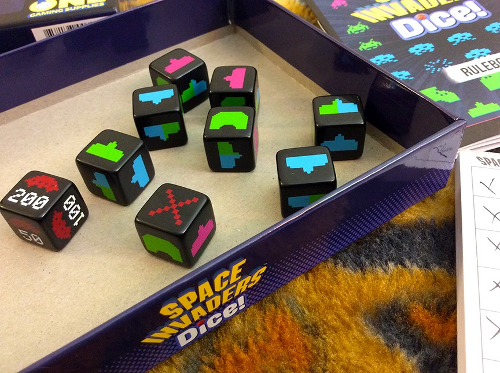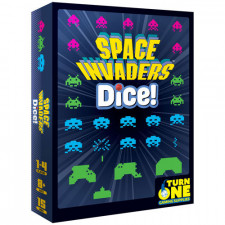Space Invaders Dice! Review
on May 9, 2017
Look familiar?
The Space Invaders are back, and they're just as ugly as you remember.
Taito's iconic arcade cabinet game returns in the form of a quick-playing roll-and-write dicefest. The box says it "plays just like the classic arcade game," and for once, the marketing is right. The simple ruleset allows for a variety of game modes, including solo, multiplayer classic, and a dice-drafting variant, but no matter how you choose to play, you'll be blasting aliens, dodging lasers, and racing to catch the high-scoring UFOs.
Each player begins the game with a scorecard and eight custom attack dice (you'll have to pass them around unless you own multiple sets). The scorecard shows the classic rank-and-file formation of 55 pixelated aliens. The bottom two rows are blue, the middle two are green, and the farthest row is pink. Most faces of the attack dice show a blue, green or pink laser, which can be used to target a matching-colored enemy. First, you'll roll and place the three laser dice to show where the aliens are firing. Then, you'll roll all your attack dice and spend them, one at a time, to cross aliens off of your scorecard, and then you get one reroll of your unused dice. Anything you can't use counts as a miss, and your ship takes one damage, two if you rerolled.
There are only two catches: you can't target an alien unless all the invaders below it have been crossed off, and you can't target any column that's blocked by a laser die unless you rolled a green shield on your attack dice. The game continues until all players have either cleared their screen or rolled too many misses, and the High Scores are then tallied and compared.
If you ever saw your initials on the Hall of Fame, you know that the real money is in the red UFOs that do random flybys in the very back row. In Space Invaders Dice!, there are eleven UFOs, one in each column. After you've shot up the column, you can spend any color laser to blow up the UFO, rolling the UFO die to add a random 50-300 points to your final score. In the multiplayer game, everyone else then has to cross that UFO off of their scorecard—missed it! Unless you've offended the dice gods, it's easy to survive long enough to clear 95% of your screen, so the real heart of the game is in the race to catch the UFOs. In this sense, it's a lot like another dice classic, Can't Stop, and the most fun moments come from seeing which columns your opponents are close to completing and stealing their thunder.

The custom dice are just colored blobs, but at least they're familiar blobs.
The problem is that this part, which contains 90% of the enjoyment, tension and score, eventually ends, and then the game keeps going for another 5-10 minutes. That doesn't sound like a lot, but remember that this is a 15-minute game to start with. It's like playing Bingo with blackout rules or taking a game of Monopoly to its plodding conclusion. Why keep playing a game after it stops being fun?
Alert, nostalgia-sufferers: the art and rules show a slavish devotion to arcade original, sometimes to the game's detriment. The scoring is identical: 10 points for a blue alien, 20 points for green, and 30 points for pink. The number of aliens is the same, which may be part of the reason the game feels too open at the beginning and too long at the end. The dice are, disappointingly, pixel-for-pixel recreations, which makes them not particularly attractive and can actually result in confusion between the green laser and the green shield. The publisher, Turn One Gaming Supplies, also makes a Space Invaders-themed d6 (https://www.miniaturemarket.com/togdce204.html) with images of the aliens on the sides; something like this would have been a more aesthetically pleasing choice than differently colored blobs.
Remember how the game would speed up as you defeated more and more aliens, until the last survivor was zipping toward you at impossible-to-match speeds? Space Invaders Dice! has this, too. As you clear out columns, you start to remove dice from your pool, representing the aliens gaining velocity. Unfortunately, it feels the opposite: instead of boosting the momentum, it just serves to make the tedious part of the game feel even slower.
There's some strategy here: since unusable dice count as damage, you'll want to find a balance between blitzing columns to capture UFOs and spreading out your shots to keep your options open. Yeah, it's simple, but I call that fidelity—the original was the kind of game you play with a slice of pizza in one hand, after all. With a few rules tweaks, it could have been the Can't Stop of Gen X nostalgia. But that's one of the advantages of tabletop games over arcade: if you don't like something, just hack it.

 Customer Support
Customer Support  Subscribe
Subscribe 




 Account
Account  Wishlist
Wishlist 

